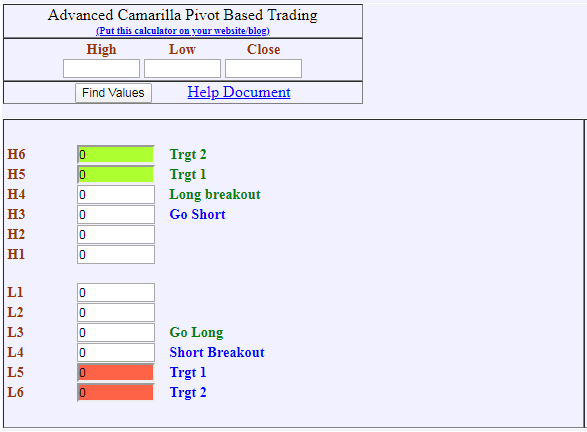The Camarilla pivot trading strategy is a better way to use pivot points to improve your trading. If you want to master pinpointing key intraday support and resistance levels, precision entry, and exit point the Camarilla trading strategy can help you achieve those goals. This is your all in one guide to what is Camarilla pivot point.
If this is your first time on our website, our team at Trading Strategy Guides welcomes you. Make sure you hit the subscribe button, so you get your Free Trading Strategy every week directly into your email box.
Apart from the standard pivot points, the Camarilla points are a more advanced and versatile version of pivot points. If you want to discover what are the hidden support and resistance levels for the upcoming day trading session the Camarilla pivot indicator can help you out.
Trading Camarilla pivot points give you a way to plan your trades ahead of time. Here are a few reasons to consider using the Camarilla pivot points indicator:
- Identify reliable support and resistance levels.
- Generates accurate buy and sell signals.
- Identify when a new trend is about to burst.
- It reveals bullish and bearish price zones of the day.
Let’s first start by explaining what are Camarilla pivot points and how they compare to the standard pivot points.
See below:
The Camarilla pivot point is a math-based leading indicator that provides accurate and automated levels of support and resistance levels. The Camarilla points contain one central pivot point along with 4 levels of support and 4 levels of resistance.
This leading technical indicator was developed by Nick Scott, a bond trader, in 1989.
See the Camarilla trading chart below:

Check out the different types of technical indicators here: Best Combination of Technical Indicators – Market Maker Methods.
To really understand how the Camarilla pivot points are calculated, let’s look first at the standard pivot points.
How Are Camarilla Pivot Points Calculated?
The standard pivot points are derived from a mathematical formula that uses the average of the high, low, and closing prices from the previous trading day. From there is an additional math formula used that gives us 2 future resistance and support levels.
Now the Camarilla formula uses the same previous day’s high price, low price, and closing price.
However, Camarilla points are adjusted for volatility by adding an extra multiplier for each level.
See below the calculation for Camarilla pivot points levels:
- Fourth resistance (R4) = Closing + ((High -Low) x 1.5000)
- Third resistance (R3) = Closing + ((High -Low) x 1.2500)
- Second resistance (R2) = Closing + ((High -Low) x 1.1666)
- First resistance (R1) = Closing + ((High -Low x 1.0833)
- Pivot point (PP) = (High + Low + Closing) / 3
- First support (S1) = Closing – ((High -Low) x 1.0833)
- Second support (S2) = Closing – ((High -Low) x 1.1666)
- Third support (S3) = Closing – ((High -Low) x 1.2500)
- Fourth support (S4) = Closing – ((High-Low) x 1.5000)
In total, you should have 9 Camarilla pivot levels. The special multiplier makes Camarilla levels closer to the price action.
Read more about day trading price action here.
This proximity is what makes Camarilla trading superior to the standard pivot points.
See below the difference between Camarilla pivot points and the standard pivot points.

Next, you’ll learn how to trade Camarilla pivot points and what Camarilla pivot trading rules you need to know.
Let’s begin…

The main idea behind the advanced Camarilla pivot based trading is based on a market principle that states the market price has the natural tendency to revert back to the mean aka the previous day closing price.
The Camarilla pivot trading rules are covering every possible trade scenario. Read more about pivoting on
Let’s see what rules you need to follow to unleash the power of Camarilla pivots:
- If you’re bullish you would be using Camarilla pivot points to buy near those predetermined support levels.
- On the other hand, if you have a bearish bias you can use the Camarilla pivot points to sell near the pre-calculated resistance levels.
How to trade trading reversals with Camarilla pivots?
These are the Camarilla pivot trading rules for trading reversals:
- For bullish reversals: Buy when we touch the S3 support level using a protective SL below S4.
- For bearish reversals: Sell when we touch the R3 resistance level using a protective SL above R4.
See the Camarilla pivot points chart below:

Let’s move on because there is another Camarilla trading strategy that you can use for breakout trading.
So, how to trade breakouts using Camarilla trading?
These are the Camarilla pivot trading rules for breakout trading:
- For bullish breakouts buy once we break and close above the R4.
- For bearish breakouts sell once we break and close below S4.
See the Camarilla example chart below:

Because it’s based on the volatility, the Camarilla pivot points will help filter out the current market condition. And secondly, under those conditions, it gives you a potential market range of high and low within which the market can trade.
The bad stuff is that not many trading platforms have built in the Camarilla pivot indicator. You may want to
The good news is that there is an advanced Camarilla pivot calculator that can supply to you the support and resistance levels.
See below:
If you don’t have the Camarilla pivot points indicator, we recommend using the Camarilla calculator HERE.
What we like about this Camarilla pivots calculator is the fact that it comes with an extra two levels of resistance (R5 and R6) and two extra levels of support (S5 and S6).
See the figure below:

The additional support and resistance levels can come into play when we have strong burst in momentum. If you want to understand how to calculate this Camarilla support and resistance levels, here you go:
- R5 = R4 + 1.168 * (R4 – R3)
- R6 = (High/Low) * Close
- S5 = S4 – 1.168 * (S3 – S4)
- S6 = Close – (R6 – Close)
The Camarilla pivots calculator only has three inputs the high, low and close price of the previous day. Once you input these values the Camarilla calculator will do the rest of the job.
Now that you have learned how to use the Camarilla pivot indicator, it’s time to reveal our Camarilla pivot trading strategy.
Let’s move on…
There are many Camarilla pivot trading strategy techniques. However, the main two purposes the Camarilla pivot indicator covers are the mean reversion trade and momentum breakout trades.
The mean reversion involves trading with the aim of the price trading back to the mean or average. In the case of the Camarilla trading strategy, we aim for a reverse back to the previous day closing price.
But, here is the thing if we try to sell each time we reach resistance R3 or to buy each time the price touches support S3 in the long-run we might not get the results we want.
The same thing is true if we’re looking for breakout trades above resistance R4 and below support S4.
We need to develop a Camarilla trading strategy that will change the odds in our favor.
Now you’re probably wondering:
How to trade successfully with the Camarilla pivot point trading strategy?
Our team of experts has the answer on how to day trade with Camarilla pivots.
See Below:
Day Trading Camarilla Pivot Trading Strategy
Mean reversion day trading inherently has lower profit margins with Camarilla pivots. The reason behind this is very simple due to the proximity of the Camarilla points with the price action you’re left with lower profit margins.
So, from the start, you have a handicap that as a trade you need to overcome.
Trading is all about finding those situations where we maximize our profits and minimize the risk.
That’s the reason why we prefer trading breakouts of the Camarilla pivot points. The profit potential is far greater. However, in order to confirm our breakout trade, we’re going to throw in another indicator.
So, what’s the best combination with the Camarilla pivot points?
The CCI or Commodity Channel Index can be used in combination with Camarilla points to confirm breakouts.
Learn more about how the pro’s trade using the CCI trading system HERE.
So, what are the rules to confirm the Camarilla pivot point breakouts?
There are two rules:
- For bullish breakout trades above the resistance R4, we need to see a CCI reading of +100 at the moment the breakout happens.
- For bearish breakout trades below the support S3, we need to see a CCI reading of -100 to confirm the breakout.
See the example below:

Note* an effective way to hide your protective stop loss would be below (above) the resistance R3 (support S3).
Now, we know that this Camarilla pivot trading strategy tends to produce less trading signals.
This means that you won’t be having a trade signal every day.
Don’t worry about it because we have one more trick in our sleeves.
We can show you a very reliable Camarilla mean reversion strategy.
This Camarilla pivot trading strategy only uses the power of divergence along with the pivot points.
Sounds complicated, but in practice is quite easy.
To simplify the process we’re going to look at buying near Camarilla support S3.
All you need to look for the price to make a new low that at the moment we touch the support S3. This means we broker below the most recent intraday swing low.
A chart speaks a thousand words. So, have a look at the example below:

In this particular example, the price broke below the support S3. Many times it will happen this way. So, don’t expect the Camarilla pivot support levels to hold to the pip. This is why we enter our position once the price gets back above the support S3.
With this Camarilla pivot trading strategy we place the protective stop loss below the support S4.
Note* Use the same rules, but in reverse for selling near the resistance R3. Also, read about the London Breakout Indicator Strategy.
In summary, Camarilla trading has the advantage of generating automatically reliable support and resistance levels. You simply can’t get a more clear and concise system than the Camarilla pivot trading strategy. The short-term nature of the pivot points makes the Camarilla trading strategy more suitable for day trading.
Another advantage that comes with the Camarilla pivot indicator is the fact that it’s a leading indicator. This means that you can plan ahead of time when the market is going to turn. By no means, Camarilla pivot points are not 100% accurate but they can give you a starting point to develop a profitable strategy around them. You may also enjoy this article with additional pivot point trading strategies.
Thank you for reading!
Feel free to leave any comments below, we do read them all and will respond.
Also, please give this strategy a 5 star if you enjoyed it!


 (3 votes, average: 4.33 out of 5)
(3 votes, average: 4.33 out of 5)

